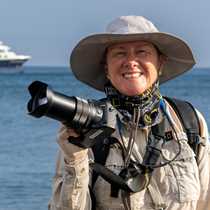Elfin Cove and the Inian Islands
Not a ripple of wind disturbed the surface of the ocean this morning as we slowly made our way through South Inian Pass. Fog was the dominant feature as we sailed west, and the surface of the plate-silver ocean was turbulent from the vast amount of water moving from Icy Strait into Cross Sound.
By breakfast we were anchored, and Mary Jo Lord, a long-time resident of Elfin Cove on Chichagof Island, came on board to brief us a little on the history of this fascinating place. Built up around a six-foot-wide boardwalk, it has the charm and quirkiness of many remote Southeast Alaskan communities. As the forecast had mistakenly called for foul weather, the hidden and protected cove was filled with all kinds of fishing boats which made it additionally interesting for all of us, photographers and others alike. Smoked salmon from Patty’s Smokery, sweatshirts and ball caps from the general store, earrings from the gift shop…many of us brought treasures back to the ship on return. In addition, as the morning progressed, we could see more and more of what lay on the northern side of Icy Straits, until finally the entire Fairweather Mountain range opened up from under our localized low cloud-cover. So it was with great excitement the first round of Zodiac riders prepared for their outing to the Inian Islands.
This week we have had tremendous tides, a difference between high and low of up to over 20 feet. Our Zodiac rides took place during a rising tide, or “flood” tide; namely the Gulf of Alaska was trying to fit through narrow (a little over four miles wide) Icy Straits to fill the inside passage of Southeast Alaska. There were standing waves and breakers, mirror-flat eddies, whirlpools and racing rivers of ocean through the channels of the Inian Islands.
The Steller sea lions were feasting on fish that were getting sucked up from the bottom, mew gulls, glaucous-winged gulls, rhinoceros auklets and marbled murrelets were all over the place, plucking smaller prey from the surface chaos. Finally, in the calm lee shore, sea otters were found, sleeping in the kelp, rolled up in fronds to keep them from drifting off during a siesta. One individual, mid-channel, had obviously had found herself an endless supply of sea urchins. Again and again, she would dive and stay down for about two minutes, then pop to the surface with a chest filled with urchins. She would then relax on her back and one by one, chow down on the urchins in record time; each urchin was gnawed open, presumably slurped dry, and the outer parts chucked away like peanut shells. Keeping her stash of urchins fresh and the table (chest) clean, she frequently performed barrel-rolls, front paws holding her remaining urchins tight until upright once more.
The afternoon was not finished, however, because as we sailed back east, thousands of seabirds flew, hovered, dived, dipped and sat on the ocean surface, feeding along the riptide lines and eddy edges. A lone humpback whale broke the flat water. And as the sun grew low on the horizon, pinks and purples joined a whale’s “rainblow,” until finally it was time to continue our journey on a path different from our whale companion. We parted company at Pt. Adolphus; the whale to feed at depth, ourselves to meet our National Park ranger for tomorrow’s adventure inside Glacier Bay National Park.




